
Part of Wilson Airport in the morning
Private homepage – Hans-Georg Michna
Kenya travel reports: 1999, 2000, 2002, 2003, 2004, 2005, 2006, 2007, 2008, 2009, 2010, 2011, 2012, 2013-Goma, 2013, 2014, 2015, 2016, 2017, 2018, 2019
Kenya Safari Travel Plan, Kenya 1980-2000 photos
Kenya 2014
A personal travel report from Kenya in May 2014
Last change: 2015-06-04 – Copyright © 2014-2023 Hans-Georg Michna
Click on the small pictures to see them enlarged, usually to 800 x 600 pixels.
Times are given in local Kenyan time in 24 h format (without "am" or "pm"), i.e. 0:00 to 23:59.
All photos are subject to copyright ©. If you want to reuse any photo, send me an email asking for permission, and I may send you the full-size photo, usually 3,264 x 2,448 pixels (8 Megapixels). These photos bear the copyright © 2014-2023 Hans-Georg Michna.
EXIF times in these pictures should carry proper time and time zone information. Kenya time is UTC + 3 h.
[I use my still new camera—a Fujifilm HS50EXR. Most photographs in this travel report are reduced to 800 x 600 pixels and JPEG-compressed with medium strength to make them more palatable for the web.]
Warning: Some Kenyan Internet service providers operate a transparent proxy server that shows you obsolete pages. They do that to save money on their international backbone connections, and it is pure fraud. If you suspect that you are getting obsolete pages, your defense is to append an arbitrary query string to the URL. For example, instead of opening http://michna.com/kenya2013/, open http://michna.com/kenya2013/?x=1234, but use a different number instead of 1234 every time. You can use the time of day or any other random string.
My (Kenyan) phone number from May 1st through June 1st will be +254724662096, good for SMS and calls, but the better ways to reach me are Threema, TextSecure, Hangouts, and email.
My travelling checklist in michna.com/kenya.htm#Preparations (German version michna.com/kenia.htm#Reisevorbereitungen) is, as always, my means of packing without fear of forgetting anything important. As usual, the packing and other preparations take at least a full day of concentrated work, because they cover an immense number of small things and details. Without the checklist I'd be lost.
This time I did not have a full day. I worked on Wednesday and left very early on Thursday. So I had to pack as much as possible on the weekend and the evenings before, which turned out to work pretty well. Most of the effort goes into technical stuff, preparations producing data and paper, copying important documents, and packing all the technical equipment. Packing the bigger bag with clothes takes only 10 minutes. It's the smaller things that take time.
KLM, Air France, and Kenya Airways on their flights To Nairobi currently allow two pieces of baggage of up to 23 kg each in the economy class. KLM also has a pretty good and informative web site, allowing ticket purchase, online check-in, and seat selection, now also for the flights operated by Kenya Airways. Let's see whether and how well that works.
The flight was perfect. I flew to Amsterdam, where I had 2½ h time, and boarded the Boeing 747 to Nairobi.
The only exception was that I tried for an hour to get a task done on the Internet that required a sequence of five web pages, but something in the connection was foul, and in many attempts I never got through those five pages. Eventually I gave up.
After I had already boarded the Jumbo Jet, I tried it once more on my phone, and then it worked. But I cannot tell what the cause of the problem was. It could have been a problem with the server, not with the Internet connection.
I can report though that on Amsterdam Schiphol airport you get two times 30 minutes Internet through the airport Wi-Fi for free. You only have to open their web page, which you get by trying to open just any web page, and click on the right button for 30 minutes of free Internet connection.
If you did that more than twice on the same day, then you would have to pay. But if you have two different devices, like a laptop and a phone, you get two times 30 min on each.
The Boeing 747 was almost full, but the seat next to me was empty. It is a wonderful and impressive aeroplane. Much of the time we flew at almost 12 km altitude and around 930 km/h ground speed.
I had my new noise-cancelling pilot Headphones with me and used them for watching two movies ("All Is Lost" and "Philomena"). This was the first time I watched movies in an airplane and understood all they said.
It is not much short of a technical miracle. When I put on the big headset, it closes off the ears and most of the outside noise, but particularly the low, rumbling sounds still come through. When I then switch on the noise cancelling, these low-frequency sounds completely disappear, and I am surrounded by silence with only a little bit of higher-frequency noise.
If you want to try that too, remember to bring the special adapter you need for the airliner set sockets, because a standard 3.5 mm plug will either not fit at all or will not transmit the two stereo channels.
After about 8 h of flight we landed in Nairobi, and I noticed how dark the airport and its surroundings are. After this flight without the usual noise I felt very well, definitely not as tired as after earlier flights. The silence and the understandability of the movies definitely ease the load on the brain.
Part of the airport had burned down last year, so I was curious how it would now work. But it worked pretty well. There is a new, large, temporary reception hall with immigration and visa counters and the baggage delivery. The passengers had to stand in line for a while, but it did not take longer than usual.
To my big surprise, a friend whom I had planned to meet in Samburu was there to collect me, along with the taxi driver I now call on his advice when I need a taxi in Nairobi. I almost emptied an ATM to get the initial load of required cash. Then we drove to my temporary home, the Aero Club of East Africa, on Wilson Airport, had a little drink in the bar (no alcohol—none of us is a drinker), then the two set out for their homes or hotels.
My single room was quite functional with a nice mosquito net over the bed, a desk, a shower, and a television set, which I never used.
The same taxi driver collected me in the morning and took me to the Rasuls Car Hire & Tours office in town, where the Suzuki Maruti Gypsy that I had used in the years before was already waiting for me. I chatted with Sajid Rasul, and I took the car to drive to my next appointment at 10 am with a doctor for the annual pilot license medical examination.
I got stuck in a traffic jam and calculated that I would be 20 min late. So I sent an SMS to the doctor's office, only to receive a reply that he would only be in at 4 pm. I had meanwhile found out that SMS from my German SIM card (simquadrat by sipgate) never worked and that communications were probably impossible anyway. But with my Kenyan SIM card there was no problem, so now I could communicate and receive answers.
It turned out that the traffic jam dissolved relatively quickly, so I would only have been late by 5 min, but that no longer mattered now. I went back to Wilson Airport and bought scratch cards in the Safaricom (my Kenyan mobile service provider) office. When I parked there, another car waited for me, so I could reverse into the parking space.
A policeman saw that, came over and asked for my driver's license. It turned out he wanted to give me a ticket for "obstruction". In a long-winded way he described how I could go to court to get my driver's license back after paying KSh5,000. The negotiation then descended into how I could avoid that and get away immediately. He proposed KSh3,000. I traded him down to KSh2,000, which was probably still more than what I could have got away with, but I am still inexperienced with these things.
I later learned that you avoid any contact with policemen on Fridays, because that is the payday for many people here, including many drivers, so the police can more easily squeeze money out of them. The simple rule seems to be, if you see a policeman, don't do anything that could possibly attract his attention. Drive nicely behind the car in front of you, don't do any maneuvers, keep your head down, and get away as quickly and smoothly as possible.
But when I drove back to Wilson Airport, I did not know this yet, and promptly ran into another police trap. The roads were all blocked by traffic jams, and I turned into a small road that I hoped would allow me to bypass at least some of the traffic jams. As I turned into the street, I saw that it turned into a dirt road that did not look very enticing. So I made a U-turn and drove back onto the main road. Big mistake!
A group of policemen stood at the corner, and you can already guess what happened. I was waved to the side and asked for my driver's license. Then I was told that I would get a ticket for making a U-turn.
This time I was already a bit wiser and tried a new strategy of insisting firmly that a U-turn is not prohibited, while at the same time being very friendly and trying to make the contact a bit more humane.
The policeman became a little unsure of himself and walked over to talk to his colleague. Then they both came back to me.
The other policeman was the first I have ever met in Kenya who knew about the international driver's license and mentioned it to me. Out of whim I had just got one before my flight to Kenya, so I could pull that out as well.
Make no mistake—this was not a rule drilled into him. He knew about the international license only because some people had shown one to him before, out of anticipatory obedience and total incomprehension for how this all works in Kenya (and probably much of Africa).
I argued pretty convincingly that I had no choice but to make a U-turn, and then we began to chat about who I am and where I come from. The second policeman apparently had some respect or liking for Germany, and the first one, it turned out, proudly owned an old VW beetle.
Then came the grand gesture in which they forwent the extraction of money and let me go. Score one, but I think I will polish my ability to become invisible to policemen, rather than my rhetorics and discussion strategy.
The morning had been sunny and nice. May and June may be the coolest months in Nairobi. In the afternoon clouds moved in, and it was overcast with some grey rain clouds visible. Later it began to drizzle a bit from time to time.
I drove to KWS (Kenya Wildlife Service) headquarters nearby on the other side of Wilson Airport to obtain a smartcard for entrance into KWS national parks. When I talked it through with the officer at the counter, he recommended that I not take one, because all the park entrances I was planning to use are points of sale, where non-residents can obtain temporary smartcards for each visit.
I quickly agreed, although I had used a smartcard the year before, because it gives me added flexibility for later changes of plan. You cannot take money out of a smartcard, once it has been paid in.
The doctor's office was fully manned at 4 pm, and I got my medical quickly.
I pondered the possibility to visit a friend on the other side of Nairobi, but decided to call it a day. After all this should be my vacation, rather than intense work. I will stay in Nairobi for another day and visit friends. And this evening I have written the travel report you are just reading.
Around sunset some heavy rain came down on Nairobi.

Part of Wilson Airport in the morning
Today my only plan was to visit friends, which I did. Thanks to my phone I could navigate and drive right through areas of Nairobi that I had not seen for a long time or ever. Technology can be helpful.
I ended up spending the night in a friend's wonderful home, which to me looks like an art gallery.
This morning I was treated to an excellent breakfast, made to order. After breakfast I soon left and drove through the center of Nairobi, which was nearly devoid of traffic, because this was a Saturday.
I continued to drive down Mombasa Road, where the traffic has steadily increased over the last years and decades. The traffic was not overly dense, but the many trucks cannot go faster than 60 or at best 70 km/h, except that downhill they can go somewhat faster, but uphill only much more slowly. And the road has only two lanes plus two repair strips, which are regularly used to avoid head-on collisions. Since much of the higher part of Mombasa Road leads through hilly terrain, this makes for some interesting driving.
I found that many people here drive by the WYSIATI principle (What You See Is All There Is, an expression apparently invented by Daniel Kahnemann and published in his new book, "Thinking, fast and slow"). This means that they drive sensibly, as long as they can see the oncoming traffic, but things are different when they cannot, like in a curve or approaching the top of a hill. For me this means that I reduce my speed to at most 70 km/h when I cannot see oncoming traffic and must suspect that they cannot see me either. I had to drive off the road onto the repair strip a few times to avoid a head-on collision, usually with a bus.
Eventually I reached Mtito Andei, half the way down to Mombasa, only to find that my left rear tyre was almost completely flat. I had already noticed that its pressure was a bit low and had pumped it up, but until then it had only lost a bit of its pressure.
The inner tube was torn, and the little workshop had a new one in stock, so the wheel was quickly repaired. See the Kenyan method to remove the tyre from the rim:
Download video file
(MP4 480p, 1.71 MB)
(In some browsers you may have to right-click the above link, then select: Save
link as …)
After a nice little lunch I continued into Tsavo West National Park, which I entered at 15:00. The entrance fee has been raised to $75 for each 24 hours, and I will be careful to be at the exit gate before 15:00 to avoid having to pay for a third day.
In the nature reserve I drove slowly, mostly between 20 and 25 km/h, to relax and enjoy the impression of the beautiful nature. Everything was quiet, apart from the cicadas. I met only two other cars going back. There were only very few tourists there.
I drove through a rainshower and had to close the windows, also because tsetse flies kept coming into the car.
I saw zebras and a group of at least three Maasai giraffes. There were also baboons along my way.
2½ h later I drove into the Severin Safari Camp that had been my favorite lodge in Tsavo West for some time. The German managers are still here and still doing a very good job. In fact, it is a camp, as its name says. There are only tents, apart from the main building with the dinner terrace, kitchen, reception, and other functions.
Over the warmer part of the day I had lost liquid through sweating and now drank Sprite and other drinks by the liter. The cold drinks felt really good.
After a brief chat with the manager I went to the dinner terrace and found that a three-person family and I were the only guests. Booking in advance had not been necessary, as expected.
The five-course dinner was really good, also as expected. While eating it, I watched an Impala buck, a big owl, and a nightjar going about his nightly business of catching insects in the air. The Impala did not eat. Instead he apparently did his best not to get eaten himself. He was very attentive to his surroundings.
Another interesting animal in a basin on the terrace was a frog species with a funny sound. There were at least two of them there, making this sound.
I had gone to bed early, feeling tired after the long day, and woke up after a full 8 hours of sleep.
I took my car and drove around in the area, enjoying the landscape and following a jackal for a little while.
I made peace with the tsetse flies and drove with both front windows open. They flew in through one window and out the other. None has bitten me so far. Even in the morning it was warm enough to feel more comfortable with open windows.
I drove up one of the hills to a place called Poachers Lookout. From there I could see Kilimanjaro in the north, which happened to be clear of clouds.
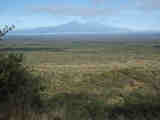
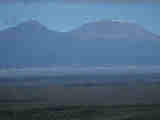
Kilimanjaro, seen from the east
I returned to camp in time for a very rich breakfast and ate my first mango here, along with other nice things like self-made yoghurt, a croissant, and pancakes.
After breakfast I tried something entirely new for me—doing nothing. But I could not do nothing for long, so I continued to write this travel report.
After lunch, of which I ate only the main course (spaghetti) and did not even finish that, I drove to Mzima Springs, a huge source of fresh water in the middle of the dry lands of Tsavo. The spring delivers a cubic meter of water every few seconds and feeds a chain of lakes.
Along the way a tsetse fly landed on my knee and looked at me with such evil eyes that I chased it away and closed the windows again. But not for long—it got too warm.
Just before getting there, a leopard surprised me. He slowly walked across the track on which I was driving. I was so surprised that I did not think of grabbing my camera before he was already disappearing into the bush. I looked after him for a moment, but he was gone for now, so I continued to the nearby springs.
On the parking before Mzima Springs I chatted with the four rangers for a while (three men, one woman), then proceeded to walk down to the spring. After looking for a while at the water pouring out of the volcanic rock structure, I continued down past the upper lake and saw a big crocodile on the opposite shore.
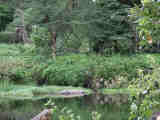
Crocodile in the upper Mzima Springs lake
Near the underwater tank, from which one can observe the fish and sometimes hippos in the water, I watched a group of vervet monkeys and was surprised that some of them were very dark-colored. A closer look revealed that those were Sykes' monkeys, a different species.
I was surprised to learn that they just crossed the path of the vervets without much interaction. They seem to respect and otherwise ignore each other.
The Sykes' monkeys showed me what they can do much better than the vervets—making huge jumps from branch to branch and from tree to tree. They often make a long jump for a hanging twig, which often bends down as if it would tear, but all the jumps I observed, even by a mother with a child clinging to her belly, were successful.
On the way back I saw first a zebra family, then a group of the elusive eland antelopes. They were as shy as always and moved away from me.
Another wonderful dinner ended the day.
I heard rain showers at night, and in the morning there was a continuous light rain until about 9:00 o'clock. I skipped the early morning sightseeing drive and had another good breakfast, starting with mango.
Spending the next night in the Kilimanjaro Sopa Lodge (formerly Kilimanjaro Buffalo) between and outside of Tsavo and Amboseli parks is a little money-saving trick. See the travel plan, section Amboseli, for details.
Some preparations and a little chat with the manager took the rest of the morning.
Officially there are convoys from Chyulu Gate to a place outside the Tsavo West park, leaving at 8:00, 10:00, and 14:00 o'clock. I arrived at the gate around 13:15 and asked for the next convoy. It turned out that they expected no other car today, so they just let me drive on without convoy and without any armed guard, which was much more convenient for me.
On my way I saw a few animals, big and small.
The way out crosses a big lava flow, called Sheitan (Arabic: devil). Even there a few specialized species make a living.
The first part of the track was not good and often had unpleasant corrugation, but later on it got much better, such that I could drive much of the distance through Maasai country at relatively high speed. It still took some 4 hours, including the few photo stops. I would plan 5 hours for the distance, because I drove faster than I should have.
I arrived in the Amboseli Sopa Lodge in the evening sun and saw this.
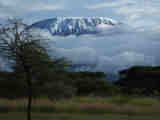
Kilimanjaro from Amboseli Sopa Lodge
The mountain top has much more snow this year than it had in many years before.
The dinner was quite good here too. I am beginning to wonder how I will lose the few kilograms this time that I lost in all previous Africa vacations.
This morning I was not in a hurry, because I did not want to enter Amboseli before 10:00 o'clock. So I had a late breakfast, then sat in the open-air part of the hotel's restaurant and continued to write this travel report.
Then I got on my way and drove the rest of the distance to the Kimana Gate of Amboseli National Park.
Just so there is no false impression, this nature reserve, like most in east Africa, is not fenced. The animals are free to leave and to enter, and many big animals make use of this, most of all the elephants, for which Amboseli is famous.
I reached the research camp site before noon, greeted the two people who were there, and moved into my airy and spacious tent to escape from the high-noon heat.
Actually it is not extremely hot. The weather forecast predicts a partly cloudy sky with highs of 28°C to 29°C and lows between 16°C and 18°C in the early morning.
I joined the elephant research assistant in the morning drive and took some photos.
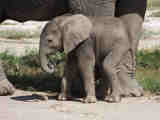
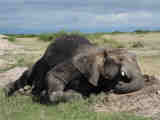
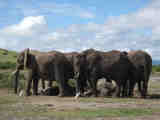
Baby elephant; adult elephant resting; mothers guarding and shading their
sleeping youngsters
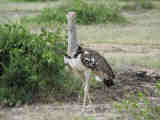
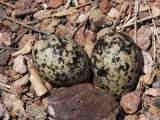
Cory bustard; eggs of a plover
On this morning's drive we met an old acquaintance, Tolstoi, a 42-year-old elephant bull.
Musth is a temporary state in elephant bulls, characterized by the active, streaming glands between ear and eye, the accompanying spicy smell, continuously dribbling urine, a several times higher testosterone level, higher aggressiveness, higher rank, a typical swinging gait, and ultimately an increased chance to mate.
Elephant cows also have this gland, but it always secretes and apparently conveys information about the female's state.
The elephants come very close to cars, but since we were in a research Landrover that they knew very well, they came even closer and tolerated our presence at very short distances, like 5 m.
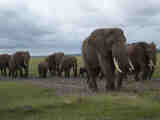
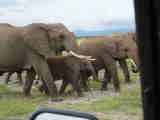
An elephant family group, accompanied by a male (left image, foreground), passes
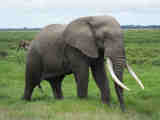
Another elephant bull in musth
We visited a German who lives nearby. Unfortunately he was not at home, but I took some photos of his compound, located on a flat hilltop.
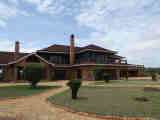
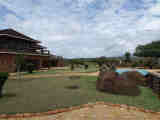
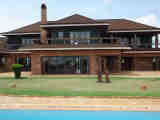
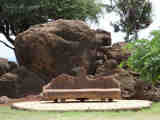
House and compound of a German acquaintance who lives here in Kenya
On the way back we saw a cheetah, a little bit too far for photography, but it is good to know they are here. A group of five cheetahs is known to roam the eastern side of the park, almost certainly a mother with four almost adult offspring, because unrelated cheetahs never congregate, except for territorial fights.
This morning I had visitors. First one elephant bull was feeding peacefully on the grass in front of my tent. Then he left and another one came and walked by. Why do I drive out at all?
Today was planned as a day of leisure—no elephant observation drive in the morning, but perhaps I will drive out later for a little while.
I took a shower in the nice, open-air, lookout bush shower. Suddenly I heard some hissing noise that reminded me of a low and fast flying sailplane. I looked up and saw three vultures in extreme high-speed flight, crossing overhead and continuing across the swamp.
The wings and bodies of vultures are primarily designed for highly efficient soaring at low speeds. They are experts in finding updrafts and circle in them to gain altitude. But of course all flying birds can tuck in their wings and reduce their surface to any smaller size, even down to zero, for high-speed flight, while keeping a high efficiency. Since the vultures already knew their destination, they could adjust their descent to a straight line, maximizing their speed.
If there is one mode of flight that vultures cannot do very well then that is lifting off from the ground. With some moderate wind speed they become entirely unable to lift off downwind, which creates a deadly problem for them when they are attacked on the ground from upwind. They always have to pre-calculate this while on the ground. But of course any wind makes it easier for them to take off against the wind, which is why they greatly prefer that direction.
The obvious problem is that on the ground they cannot flap their huge wings, compared to their bodies, downward as much as they can in free flight, because the wings would strike the ground. Since they also do not have long legs, like for example Marabu storks, and since they have to begin with speed zero, this makes taking off less efficient than free flight.
Vultures generally avoid having gain altitude by muscle power. Apparently they are underpowered for muscular flight. What they do instead is this. They take off from the ground, using their limited muscle power, and land on a nearby tree. There they wait for an updraft, which is a frequent occurrence in sunny Africa. Judging from my own observations, they are extremely good at judging the strength and location of these updrafts.
Once they feel or hear a suitable updraft, they lift off from the tree and use some muscle power to get into the updraft as quickly as possible. If necessary, they keep flapping their wings to reach an altitude where the updraft has enough strength to lift them further up, hardly more than 30 m above the ground. Then they circle and often very rapidly gain height.
Finally, after almost reaching the bottom of the clouds, they leave the updraft and move on. In downdrafts they increase their speed, in updrafts they reduce it or circle to regain altitude.
The myth of the vultures circling above their prey is, obviously (to someone who knows vultures) complete nonsense. When a vulture sees a carcass, he goes there in a straight line and at the highest possible speed, also trying to avoid being seen by other vultures, his competition.
If the prey is still protected by stronger animals, like hyaenas or lions, vultures land on a nearby tree. As the first eaters become satiated, the vultures lower themselves to the ground and move ever closer to the carcass, while trying to get on the nerves of the eating predators to make them move away sooner.
Later I drove along the northwestern boundary of Amboseli to discover new tracks and to take photos. It was a long drive ending in very beautiful evening sunlight.
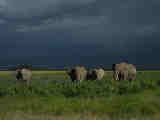
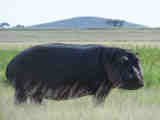
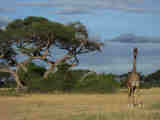
Elephants near the swamp; hippo; Maasai giraffe
Hippopotami normally graze at night and spend the day submerged in rivers and lakes, but if they feel very safe, they sometimes come out of the water early. This is how I got to see this big, adult hippo in broad daylight.
This morning the mountain top was cloud-free for a little while, so here is a photograph of my current dwelling in the AERP (Amboseli Elephant Research Project) camp.
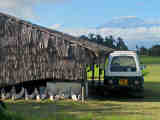
My tent under its thatched roof, my car, and Kilimanjaro
Nkoshopu, the young Maasai who works in the camp, and I did a mid-morning sightseeing drive and saw many elephants, wildebeest, two hippos, and many other animals, particularly three hyaenas who were walking along the swamp. Here is one of them.
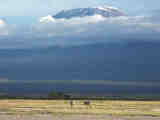
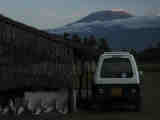
Zebras in front of Kilimanjaro; My tent and car at sunset
I left Amboseli after these wonderful days and drove through Namanga – Bissil – Kajiado – Kitengela – Athi River to the International Airport just before Nairobi to collect my wife.
Along the way I visited friends in the Kajiado area. Then I still had some time left over and used it to have a look at Orly Airpark, the new light aeroplane airfield just outside the Nairobi control zone, a 15 nautical mile circle, in which flying is only allowed while being controlled from the ground.
This endeavor proved much more difficult than I had expected. I ended up seeing the runway, but not the buildings. The roads were not very good either, and I got out of that area only after using up my spare time and when it got dark.
So I had to drive through Kitengela at night, which was an adventure I will not forget any time soon. the whole road and its two side streets were one huge traffic jam with pedestrians, bicyclists, and motorcyclists all winding their way through the irregularly moving cars. My subjective impression was that at least 10 people would die in traffic accidents this evening, but somehow I managed to avoid being involved in any of these. In truth, probably nobody died this evening, because the Kenyans somehow manage this kind of traffic, but the number of traffic deaths in Kenya is, in fact, high.
I arrived at the international airport in time and thought I should get some Kenya Shillings from an ATM. I entered 40,000 KSH, but got only 24,000. This may be another case of ATM fraud, which I had seen before.
I turned to the cashier in the nearby counter of the same bank (Barclays Kenya) and quickly wrote a letter to the manager, complaining about the missing KSH16,000., equivalent to some €130. The cashier said that I would get the money refunded to my credit card, but I don't believe it. A bet, anyone?
We drove to the Aero Club of East Africa and spent the night there.
This was a very busy day, beginning with a drive back to the international airport to visit the KCAA (Kenya Civil Aviation Authority) to renew my pilot license and a visit to Rasuls to have the car checked and the clutch slightly adjusted.
After that we had a small lunch in the Aero Club and moved out to visit friends in various parts in Nairobi. Our third visit also became our overnight stop.
After a nice breakfast with friends we drove off towards Nakuru, where we checked into the Nuru Palace Hotel. The courtyard of the hotel was full of people who turned out to be participants of a teachers convent taking place in the hotel and lasting the whole week.
But the teachers did not sleep in the hotel, so we got a small, but usable double room.
After settling in we waited until a friend of ours got away from her workplace and drove to her nice house outside the city, where we spent the evening, returning to our hotel later at night.
Our next stop was Lake Baringo with the small village Kampi ya Samaki (fish camp) on the shore of Lake Baringo.
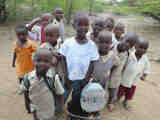
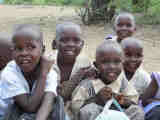
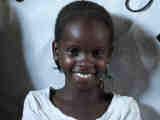
Baringo children; Baringo children; Shamsi (10), daughter of friends
We met some friends there and prepared for the long drive to Samburu the next day.
However, we got news of a car robbery along the road from Wamba to Archer's Post, in which at least two cars were shot at and robbed, killing a driver and a passenger and injuring others.
Although this was not on a stretch of the road that we would be driving, we decided that we might as well drive another route for a change.
We spent the night in Roberts Camp and enjoyed the little, but fine restaurant, the "Thirsty Goat", and observed the hippos that were in the lake only meters away from our dinner table.
We woke up at 5:15 and had a good breakfast at 6:00. Then we started on our very long trip via Nakuru (yes, we had to drive back there) – Bahati – Subukia – Nyahururu (Thomson Falls) – Mweiga – Naro Moru – a short lunch stop at the wonderful Barney's – Nanyuki – Isiolo – Archer's Post – Samburu Game Reserve.
We reached the Samburu Lodge, our accommodation for the coming week, at 6:00, feeling a bit exhausted, but not too bad. 400 km in 11 hours is not an uncommon speed for a long-distance drive in Kenya. Even though we could drive a large part of the distance on excellent roads, the very slow parts pull down the average speed.
This day was dedicated to resting and having some first meetings with friends here in Samburu. We wanted to make a late-afternoon sightseeing drive, but an approaching thunderstorm made us reconsider.
It turned out that the thunderstorm dissolved before reaching us. Only a few raindrops actually came down on the lodge. I used the time to make this travel report catch up with reality.
I typically drive out either before or after breakfast and again for the last two to three hours before sunset to see the animals. Some photos:
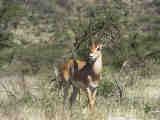
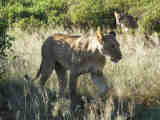
Male Grant's gazelle;
lionesses
The lionesses looked meager. This is, unfortunately, normal at the end of the rainy season, which is a good time for large herbivores, but a difficult one for large predators.
One of the two lionesses has a cub which I have not seen yet. If she is diligent and lucky enough to find and catch sufficient prey to eat, the cub will survive.
On the next day I found the two lionesses again and photographed one.
We found them once more in the evening, but we also found a very beautiful leopard.
We stayed with the leopard until the light became so low that we could no longer take photos and could barely see him. Then we drove back to the lodge, only to have our rear right tyre go flat.
We jumped out of the car and I changed the wheel while my wife was keeping the leopard at bay with the jack crank.
OK, I have to admit that was slightly exaggerated, but we did swap wheels in the record time of 15 minutes, because we wanted to use the last bit of daylight to drive "home".
But it was already too late. We had started in the last bit of dusk, but by the time we had changed the wheel it was pitch dark. It was not a big problem though. We drove the few kilometers back to the lodge slowly and found that a few people had already begun to worry that we were missing.
I made a mental remark that (a) I should always visually check all tyres before starting the car and (b) I should always carry a spare tube.
Repairing the tyre turned out to be more difficult than we had hoped. An earlier patch had come loose, revealing several holes.
The lodge's service station did even have matching inner tubes, but they were designed for tubed tyres, which require a bigger valve hole diameter in the rim. Our rims were made for tubeless tyres. They were later retrofitted with inner tubes, because the tubeless fit does not survive the African roads for long enough to justify tubeless operation. Usually the rims get banged too hard, get bent, and lose their tight fit too soon.
After putting a big patch over the holes in the tube, the electricity went out, and we had to wait until lunch time, because the compressor needs electricity.
After this repair was done it turned out that the tube had another hole and areas that were weakened apparently by something rolling around between tube and rim. We decided to add another patch, by which time the electricity was out again.
So this was a day without driving out. But we had invited our lion researcher friends for lunch, so the day remained interesting and nice.
In the morning we had a short drive, but saw a lot of interesting animals like a flock of more than 100 vulture-headed guinea fowls. I also recorded their voices (below).
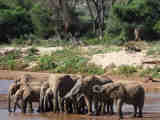
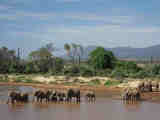
Elephants drinking and crossing the river
We were invited for lunch to the camp site of the lion research project and had a very good bush lunch and an interesting afternoon there, before we returned to the lodge in the evening.
In the morning we found the twice-repaired wheel to be flat again. Also, some oil was seeping out of it. I had thought that they had used water to make the tyre slip onto the rim more easily, but they had used oil. That is not a good idea, because oil softens and tends to dissolve rubber. In any case we had to conclude that this tube was beyond hope, so we had to find another one. I also made them wash the tyre with soap to remove the oil.
A recommended workshop in Archer's Post did not have these particular tubes in stock, but offered to get them from Isiolo. Also one of the Lodge's drivers was in Archer's Post at the time and was willing to get the tube from Isiolo. So we stayed in the lodge and did other things to make the best use of the time, like continuing to write this travel report. I also concluded that it had been a big mistake not to bring along a spare tube. I have already incorporated this in the travel plan.
I would have loved to join this evening's giraffe field observations, but I had to wait for the tubes and make sure one was put into the problem wheel as soon as possible, so I stayed in the lodge, while the giraffe researcher and my wife went into the field.
Late in the afternoon the driver finally arrived and indeed brought two new tubes. They were of the right type, so we could finally solve the problem of the flat tyre.
While I was receiving and inspecting the tubes, I received a telephone call instructing me to come to the entrance gate of the lodge immediately. It is very urgent, I was told. So I paid the driver for the two tubes and ran to the gate, where I met the giraffe research car. They wanted to show me something akin to one hundred dancing ostriches. I jumped into the car, we turned around and dashed off into the hilly country in the north.
They did not tell me exactly what they wanted to show me, but as we reached the far end of the valley, I saw them.
I had looked for them for 36 years and never seen one. It was my last African dream, a species so rare and elusive that I had already resigned myself to never see it in the wild. But suddenly here they were, in a place where I had looked for them time and again unsuccessfully.
And they were neither shy or afraid of our car, nor did they dash off and disappear where we could not go. They had just got up from their afternoon nap and were now apparently looking for suitable prey to hunt. They set off to the south, towards the river, and we drove on with them on our side through the fairly open bush savannah.
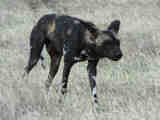
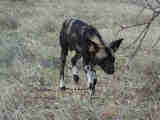
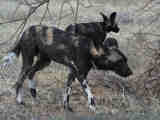
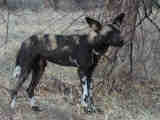
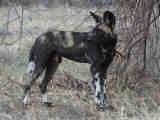
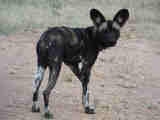
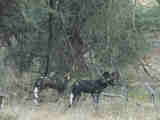
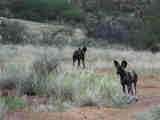
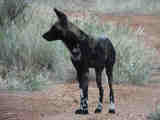
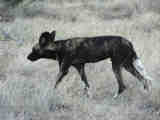
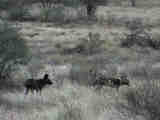
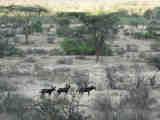
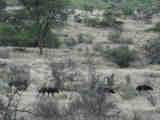
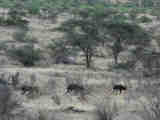
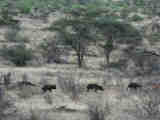
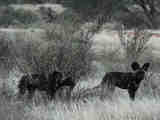
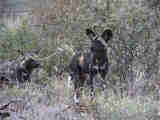
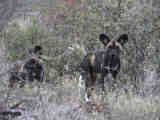
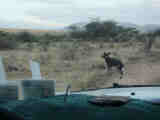
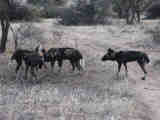
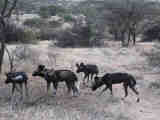
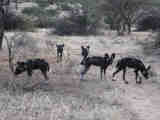
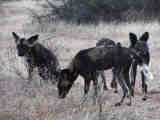
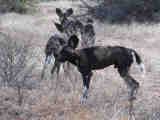
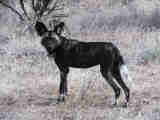
African hunting dogs (the "painted dogs")
I apologize for the unusually large number of photos, but since these are the only ones I could take in all of 36 years, I hope the size of this collection is justified. I also apologize for the cold colors. The reason is that the dogs were moving along the eastern hill side, so the late evening sun did not reach them.
As they strolled through the savannah, one scared up a hare that ran away and was immediately followed at high speed. After a few seconds of pursuit one of the five dogs made a jump and apparently got the hare after a spectacular somersault, but by a very narrow margin the hare escaped. The dog followed him a little further, but lost him between rocks and bushes. I guess, since a hare would not satiate the whole pack anyway, they left him behind and continued toward a sizable herd of Oryx antelopes.
The antelopes formed a circle and counter-attacked the probing dogs. The long, pointed, saber-like horns of the Oryx antelopes are formidable weapons and could kill a dog easily. The firm resolve and counter-attack of the antelopes convinced the dogs quickly that they had better look for easier prey.
Both encounters went too quick and at some distance ahead of us, so we could see and observe, but not photograph. When our car finally arrived at the scene, the dogs were already moving on.
We drove with them until the sun set and would have continued even a little further, but then they went across a place without drivable tracks. When we got to the other side after a little detour, we could not find them again, so we went back to the lodge, very happy and satisfied that we had been able to observe the dogs better and for longer than we could have reasonably hoped for.
In the morning we were very lucky to see three kudus out in the wild. These animals are mostly nocturnal, shy, and very difficult to find, partly because they tend to live on inaccessible hill slopes.
We also saw the inevitable and ubiquitous Impalas.
Later we found a very photogenic dikdik, a tiny gazelle that can survive in dry areas away from water allegedly by licking dew.
But the crown of this day's observations belongs to a lioness. We were watching waterbucks across the river, feeding on some lush grass, when we suddenly noticed that we were not the only ones who were interested in the waterbucks. We had completely overlooked a lioness less than 10 m from our car, perfectly aligned in the direction we were looking.
After a short while she gently slid down into the riverbed and began to stalk the waterbucks. Whenever they looked up, she froze. When they continued to feed, she resumed her time-lapse movement towards the waterbucks.
To move towards waterbucks in an otherwise flat riverbed without any cover proved unsuccessful, but we could not know whether other members of her pride were laying in hiding to catch a waterbuck as he fled from the attacking first lioness. We did not see any other lion in the area though, and after the lioness had already crossed half the width of the river, one of the waterbucks did eventually notice the danger and ran away. The others followed him.
I find it astounding that the waterbucks apparently did not recognize for a long time that the only conspicuous object in the middle of the river was a lioness, i.e. a dangerous predator. They reminded me of reptiles, which see only moving objects.
Download video file
(MP4 720p, 85.2 MB)
(In some browsers you may have to right-click the above link, then select: Save
link as …)
In the late afternoon we turned to giraffe observation again and drove out in the giraffe research car. We soon found a dozen giraffes in one area, most of which formed a group that moved together while feeding. We photographed each giraffe from both sides for identification.
We also found a small group of Grevy zebra.
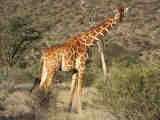
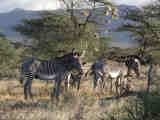
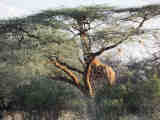
Giraffe; Grevy zebra; another giraffe feeding on an acacia tree
On our way back to the lodge around sunset we spotted a lioness with her cubs in the bushes near the river.
In the open-air dining room of the lodge there are some regular visitors, looking for a bit of food from the plates of the lodge guests.
Finally our wonderful time in Samburu came to an end, and we set out in the morning to reach Nairobi before dark.
On the way out of the Samburu nature reserve we saw a rare animal that is indigenous only in some northern dryland areas—the desert warthog.
Our drive to Nairobi was long, but uneventful. We arrived in the Aero Club of East Africa before dark.
After an early breakfast we drove off towards Masai Mara. On a Sunday the city is nearly empty, so we simply drove the fastest route right through the city of Nairobi, then in northwesterly, later northerly direction on the four-lane freeway towards Nakuru.
We turned off and entered the road to Mai Mahiu, which goes down the steep edge of the Rift Valley, offering a spectacular view across the valley and at the volcanos Suswa and Longonot.
In Mai Mahiu we turned off again onto the road to Narok, where we filled our tank and ate a little snack. The roads up to here and another 25 km thereafter were good or mostly excellent.
But the first 60 of the last 80 km to our destination could only be described as the highway to hell. We were driving there through the hottest part of the day, so we could not keep the windows closed. The road, if you can call it that, was rough to extremely rough, but also extremely dusty. For the most part we had the additional bad luck of having the wind blow from behind, rather than from any side.
This means that whenever another car passed us in any direction, we quickly cranked up the windows, switched off the ventilation fan, and stopped, because we could not see anything. This part took us approximately 4 hours.
Many other cars, particularly the tourist minibusses, have better suspension, like independent wheel suspension, rather than the rigid axle like on our little car. So they drive much faster than we do, but the roughness of the road is such that no car is safe from damage when you drive faster than some 15 km/h.
We found one of these minibusses with a broken axle. The front right wheel looked funnily twisted out of direction. The driver asked us to call the nearest mechanic for help. So we did, only 1 km down the road. The mechanic swung himself onto his motorcycle and raced back to the broken car, while we continued on.
We should later meet this driver again, because his destination turned out to be the same as ours. He then thanked us for our help, which had been the key to the repair of his minibus, but he had had to drive back to Narok for a complete repair.
Eventually we reached Sekenani Gate, the entrance to the Masai Mara nature reserve. After paying our fees we continued along the main track, which was not much better than the one outside, but we soon turned off and drove along smaller tracks through the bush.
Just after the gate we were greeted by a group of the shy and elusive eland.
Soon thereafter we met lots of zebra, topi, warthogs, and various gazelles. Once more we had arrived in the real world or perhaps in one of its last bits that still represent primeval nature.
In the morning another of our tyres was flat, this time the front right one. It was quickly repaired in the lodge's workshop, but it still took too much time away from a potential morning drive, so I stayed in the lodge and filmed ants instead that were apparently moving into a new home next to our tent, luckily not into our tent. They tend to eat everything that is in their way.
Note how the ants build walls on either side of their freeway, using themselves as building material.
Download video file
(MP4 720p, 4.23 MB)
(In some browsers you may have to right-click the above link, then select: Save
link as …)
In the afternoon we drove parallel to the river Talek in the downstream direction to a point where we knew that hippos stay there in the river. Along our drive we saw more zebras, a group of wildebeest, giraffes, and eland among gazelles and other animals.
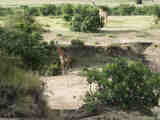
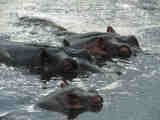
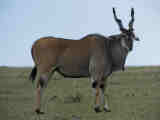
Giraffes at Talek river; hippos in the river; eland bull
Because thunderstorms formed in several directions, we turned back towards the lodge some time before sunset and spent some time at the camp fire.
On our morning drive we saw many animals, but nothing spectacular enough to take many photos. I liked these zebras though.
In the afternoon we tried to contact a research project by visiting its camp. However, we had to turn back in the face of an approaching thunderstorm.
For the whole time we had been here the weather was quite predictable. Clear blue sky in the morning, some clouds in the afternoon, some rain in the evening or at night. The rain comes from isolated thunderstorms or from what remains after they dissolve.
Last night I woke up around 4:00 from the gurgling sound of water rushing down the river Talek. The water had been low and standing still all the time before. Apparently some heavy rain had come down somewhere upstream from here. About an hour later the sound of the water very slowly began to subside.
During the day the water was still high and slowly flowing. Later I found that the hippos had come back from their refuge a few kilometers downstream. One walked by my tent in the river as I wrote this in the evening, just after dark.
For today we had planned to drive to the big river Mara on the western side of the Masai Mara nature reserve. Since the annual wildebeest migration had already begun, we wanted to try to see them cross the river.
This is certainly a difficult endeavor, as we first have to find a likely point and second to find a place to hide well enough that the animals are not irritated enough to delay their crossing.
We would be missing lunch in the lodge, but in this case they always hand out lunch packs when ordered in time on the day before, which we had done. We received them at breakfast time and drove out after our early breakfast.
We found the way easily and stopped occasionally for interesting wildlife. The most interesting this morning was a 3 m long Python, slowly crossing our path.
We jumped out of the car to take photographs, but its head soon disappeared into the grass, so you will have to look at several photos to see the whole snake.
After the python had slowly crawled into the grass, we turned the car alongside it to take a few more photos, more or less from above, out of the car window. But then the most peculiar thing happened, which we still do not understand.
The python immediately turned 90° and crawled under our car. If we did not want to kill it when we would drive off, we had to wait until it came out completely on the other side, but it never did. We waited and looked on all sides, but we did not see the snake anywhere.
Eventually I moved the car very slowly and piecemeal, i.e. two inches back, one inch forward, then back again, etc., in the hope that, if one of our tyres squeezed the python, it would have time to get away. Then we scanned the whole place where our car had been, but there was absolutely not trace of the python.
We joked that the python had somehow gotten into the lower parts of the car and was still riding with us. We later even checked the engine compartment, but it was not there. The vanished python remains a mystery.
The driver whom we had helped to get his broken axle fixed when we drove here turned out to have had the same destination—our lodge. He explained his gratitude for our earlier help, and we asked him for directions.
He explained how to find the wildebeest river crossings. On the side south of the river Talek the best strategy is to drive up the highest hill in the area, called Lookout, and scan the river Mara from there for congregations of wildebeest on the other side. Then one drives to that place and waits for the wildebeest to cross.
We found the Lookout hill easily and stored its coordinates and the way there for later use. But scanning for wildebeest proved unsuccessful. The numbers of wildebeest we had seen already in the days before were significant, but not very high. They mean that a small fraction of all migrating wildebeest had crossed the Mara, but most were still to follow, but apparently not today. So we made the best of it, drove down to the river and followed it in a northerly direction, i.e. upstream towards its tributary Talek.
The river is home to many hippos.
We also met a pride of lions, taking their daily siesta in the shade of bushes.
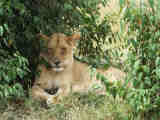
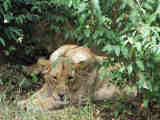
Sleepy lions near the river Mara
After a while we turned away from the river and headed back to the last river crossing of another tributary, which we needed to get back "home". From there we drove straight north until we met Talek River and continued upstream to our lodge, expediting a bit because of a looming thunderstorm ahead. The "black cotton" soil that prevails in much of Masai Mara becomes incredibly slippery in rain and makes it almost certain that you will get stuck, so we wanted to avoid it.
But we still found the time to watch a bunch of striped mongoose.
It turned out that the rain dissolved before reaching our lodge, so we still found the time for a short evening drive.
In the evening after dinner we sat at the camp fire and watched more animals, a praying mantis that had got lost in the dark and a bush baby.
We had tried to contact a research project in the area, but had not received any reply, so we decided to look for their camp site and see whether it is in use at all.
On the way there we found another group of eland that was not too shy to be photographed.
We also got a chance to photograph a hamerkop.
Since it had rained in that area the night before, driving was difficult. We had to cross a couple of small rivers and could not take any considerable risk of getting stuck in this more remote area, but we reached the entrance to the bushy area in which the camp was located. But the last small creek was unpassable, and the track had apparently not been used recently.
So we turned back and tried an entrance on the other side, about 600 m to drive. On that side there were fresh tracks, so we knew already that the camp was used. But the area became wetter, the deeper we drove in. 300 m before reaching the camp we could not go on any further, because a whole large area was too muddy for us to cross. The smaller wheels of our car and our lack of experience with this particular track made it too risky for us to continue.
We pondered the thought of walking to the camp, but we quickly gave up this idea, because we knew that this was not without danger. Sometimes buffalos hide in the bushes, and a meeting with a buffalo on foot is a good recipe for untimely death. Not to mention that I would have lost my shoes in the mud.
So we sadly had to give up and turn back. We took a different route back and at least enjoyed some good sights and landscapes.
Back in the lodge I took the following photo directly from our tent at the river.
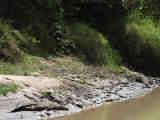
Crocodiles warming up in the mid-day sun
After lunch, later in the afternoon, we drove out again and took more photos.
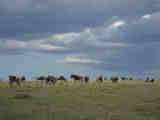
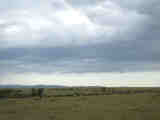
Wildebeest; migrating in single file
A young jackal sat in the grass very close to our car, but still we almost overlooked it. It did not want to move and was not particularly afraid of our car.
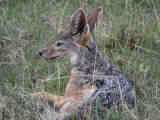
Juvenile jackal waiting for its mother
We got back to our camp in time for dinner, and afterwards saw this genet cat, lured into the lodge compound by some tasty food, particularly some meat and bananas.
I will mention again that Genets are not really cats; they are more closely related to mongoose.
The next morning we decided to drive in a direction we had not yet tried. We drove across wide grassy plains that are very pleasant to look at. Then we came to a small river and drove along it, when we found a point where we could cross that river. Just beside that point we saw this scene.
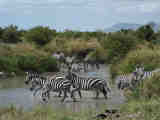
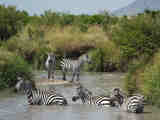
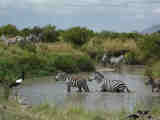
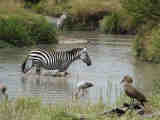
Zebras, also Saddle-billed stork, Yellow-billed stork, hamerkop
On our way back we found this vulture, apparently on its nest in a tree.
We returned to camp for lunch. After lunch we went to our tent and saw elephants right across Talek River, which we photographed while sitting on the porch in front of the tent.
Of course we had to drive out again on our last day in Masai Mara. The drive was beautiful, through wild landscapes, across the grassy plains, along bushy rivers and many zebras, wildebeest, topi and many other ungulates. Here is my last photo.
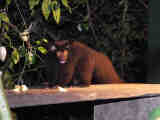
The bush baby comes again on our last evening
The next morning we had an early and quick breakfast before being on our way back to Nairobi past Sekenani Gate and the "highway to hell". It was not quite so hellish today, partly because the wind blew from the side, so we could avoid some of the dust, partly because we found better ways to avoid the main track, and partly because we knew already what to expect and how long it would take.
We took our first and only break in Narok, then headed back across the Rift Valley. After driving over the foot of Mt. Suswa, we had our fourth flat tyre, again on the rear right wheel that had already had two earlier breakdowns.
We gathered that either the tyre or the rim must cause these problems, mounted our spare wheel, and decided that we did not have enough time and inclination to repair the failed wheel, only to see it fail again. We contacted Sajid Rasul, knowing that he would rescue us if another tyre failed, and drove on along the spectacular road out of the Rift Valley.
Because there was a large rallye by the political opposition in Uhuru Park, we avoided the route along Uhuru Highway, drove off the freeway early, and drove around the western and southern edge of Nairobi, through Karen and Langata directly to Wilson Airport. The drive was fast, and we missed our overly optimistic plan by only 1½ hours. This meant that we could do all the remaining driving in Nairobi during daylight.
I delivered the car back to Rasuls home, paid up, and had asked Jacob, the taxi driver, to collect me there and take me back to the Aero Club of East Africa for the last, short night.
Sometimes I cannot sleep very well when I know that I have to get up very early to catch an intercontinental flight, and this night was one of those. I began to read when I noticed that I could not easily fall asleep, but did finally sleep a few hours before my bio-alarm-clock app woke me at 4 am.
We had heard that there is now an additional security check at the entrance of the international airport and that this could take an hour. I did not believe it, but planned for an extra half hour nonetheless.
As it happened, the waiting time was much shorter, perhaps not even 10 min, but I cannot say whether it would always go as quickly as this. So, if you fly from Nairobi, you normally want to be at the airport a little more than 2 hours before departure time, and now you want to be there no less than 2½ hours before departure.
Since we were there quite early, everything was empty, and we did not have to wait for the baggage drop. Since we could not print our boarding cards, we used one of the automata, which quickly checked us in and printed our boarding cards.
This year for the first time we did not have to fill any forms. Instead we had to have all 10 of our fingerprints taken by a machine. At least this is faster and much more convenient than the old paper method.
After a little breakfast in the airport restaurant we boarded the Kenya Airways Boeing 777-200ER and soon took of along the 4 km long runway, which is so long because of the thin air at this altitude (and heat during the day), requiring a higher takeoff speed and more runway than at lower altitudes and temperatures.
But the big twin-engine plane had no problems accelerating to almost 300 km/h and taking off steeply. After all, a twin-engine plane has to have a 100% power reserve as long as both engines keep running.
The flight was very beautiful. It took us past Mt. Kenya, then all along Lake Turkana, the former Lake Rudolph, then across a corner of Ethiopia, into the Sudan, over Khartoum, along the Nile and across Lake Nasser to the Mediterranean Sea near Alexandria. Then we flew over the eastern corner of Crete, past Santorin, over several more Greek islands, via Albania and Austria, past Regensburg, to the north of Nuremberg and Frankfurt to Amsterdam.
We had two hours to change planes, did a little window shopping, and entered the KLM Embraer 190 that took us back to Munich in not much more than one hour. The easterly wind did not help us, but it made sure that our takeoff and landing were both straight and did not require any circling, which shaved at least 15 minutes from our flying time.
Our elder son collected us from the airport. I was made to drive and experience the culture shock of feeling like sitting very low, almost on the road, not having to look for potholes and speed bumps, driving 50% faster than our fastest driving speed in Kenya, and finally arriving at home a little tired, but in very good shape.
I occasionally have to mention the downsides of Kenya, which do not show up in the nice photos and stories above, but have an influence on the experience nonetheless. One of them is the continuous degradation of Kenya's nature reserves, which I will show here.
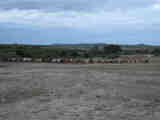
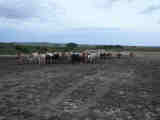
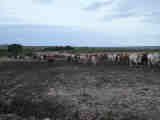
Cattle are driven into the Masai Mara nature reserve at sunset
In Amboseli, Samburu/Buffalo Springs, and Masai Mara huge numbers of livestock are regularly inside the nature reserves. The pictures above show the situation in Masai Mara, where cattle are driven into the reserve every night, trampling and eating bare large areas that are normally covered with dense grass. Apparently to appease the tourists they are driven into the reserve in the evening and often, but not always, driven out again before sunrise.
This was the end of the rainy season, where grass is abundant inside and outside the nature reserve. If the herders deem it necessary to drive their cattle into the reserve even during the best time of the year, I wonder what they do when conditions for their livestock are poor, like at the end of the dry season.
The plight of Masai Mara began when its former size of 1,821 km² was reduced to 1,510 km² in a process that ended in 1984. The worst was not the reduction in size, but the fact that the area taken from the reserve created a bridgehead into the reserve in the area around the new settlement Talek directly to the north of Talek River. This river formerly once flowed through the reserve, but is now the northern border of the reduced reserve.
The river made it possible to get water for large numbers of livestock. The Talek settlement as the center of the cattle ranching operations sprung up directly at the shore of the river. To have a small river that can easily be crossed by livestock as the border of a nature reserve is about the worst that can happen from a point of view of nature conservation. It is a recipe for conflict.
Livestock and humans in nature reserves have other side effects, like conflicts with large predators. Lions fear humans, but if they pass by every night, they get used to it, and it is only a question of time until a cow wanders towards a pride of lions, and I have yet to see lions run away from any potential prey. Once the lions learn that cattle are easy prey, the conflict probably escalates, and it is your guess who always wins.
In Amboseli the number of livestock I see regularly exceeds the number of wild animals. There I have already seen children accompany the herds, begging from tourists. Amboseli may be a special case, because at least during the dry season the Amboseli swamp is one of the few sources of drinking water for all animals. But the herds are inside the reserve during the wet season as well.
Unlike the other two or three nature reserves I mention, Amboseli is a national reserve, managed by KWS (Kenya Wildlife Service). They are known for their relatively strict rules, but while a tourist car violating these rules by driving off-road over grass for 20 m, the wheels thus rolling over a couple of square meters of grass, can receive a heavy fine, livestock herds, which damage an incomparably larger area, are the norm. This is not easy to explain.
Samburu was a special case this year, because the bridge connecting the Samburu and Buffalo Springs nature reserves had been swept away by floods twice. Since Samburu has long been the reserve favored by tourists and without the bridge crossing over was impossible, there were hardly any tourists in Buffalo Springs. This led to the entire Buffalo Springs reserve being used as a large cattle, goat, and sheep ranch. Conflicts with large predators were unavoidable, and herders have killed lions inside the Buffalo Springs nature reserve.
The poaching of elephants in Buffalo Springs and Samburu also increased a lot, such that many elephants left both nature reserves, seeking refuge in the West Gate area west of the Samburu reserve and further afield.
At the same time the entrance fees for these nature reserves have been going up, soon going to match the prices for standard lodges and thus doubling the total price, so I wonder whether the increasing worldwide wealth will make up for this or whether tourists will decide to go elsewhere. Even though it would be sad for me, if I can no longer afford to go there, I would still appreciate it if the higher prices led to better protection of the nature reserves, but I have yet to see that.
Further reading:
If in this text you find any typos, orthographic errors (even small ones), ungrammatical sentences, wrong or illogical information (like wrong names of birds), if you want me to write more details about something in particular, or if you want one of the photos in full resolution (usually 1,600 x 1,200 pixels), please click on the email sign below and write to me. Many thanks!
Copyright © 2014-2023 Hans-Georg Michna.
Private homepage – Hans-Georg Michna
Kenya travel reports: 1999, 2000, 2002, 2003, 2004, 2005, 2006, 2007, 2008, 2009, 2010, 2011, 2012, 2013-Goma, 2013, 2014, 2015, 2016, 2017, 2018, 2019
Kenya Safari Travel Plan, Kenya 1980-2000 photos
hits since 2014-04-24
Free PHP scripts by PHPJunkYard.com